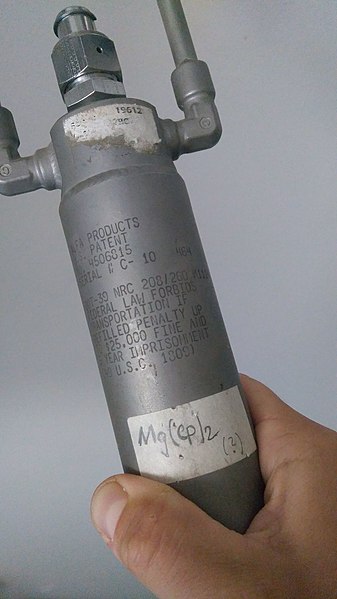Organopalladium chemistry
Organopalladium chemistry is a branch of organometallic chemistry that deals with organic palladium compounds and their reactions. Palladium is often used as a catalyst in the reduction of alkenes and alkynes with hydrogen. This process involves the formation of a palladium-carbon covalent bond. Palladium is also prominent in carbon-carbon coupling reactions, as demonstrated in tandem reactions.
Sample of PdCl2(1,5-cyclooctadiene).
Organometallic chemistry is the study of organometallic compounds, chemical compounds containing at least one chemical bond between a carbon atom of an organic molecule and a metal, including alkali, alkaline earth, and transition metals, and sometimes broadened to include metalloids like boron, silicon, and selenium, as well. Aside from bonds to organyl fragments or molecules, bonds to 'inorganic' carbon, like carbon monoxide, cyanide, or carbide, are generally considered to be organometallic as well. Some related compounds such as transition metal hydrides and metal phosphine complexes are often included in discussions of organometallic compounds, though strictly speaking, they are not necessarily organometallic. The related but distinct term "metalorganic compound" refers to metal-containing compounds lacking direct metal-carbon bonds but which contain organic ligands. Metal β-diketonates, alkoxides, dialkylamides, and metal phosphine complexes are representative members of this class. The field of organometallic chemistry combines aspects of traditional inorganic and organic chemistry.

A steel bottle containing MgCp2 (magnesium bis-cyclopentadienyl), which, like several other organometallic compounds, is pyrophoric in air.
a single crystal of a Mn(II) complex, [BnMIm]4[MnBr4]Br2. Its bright green color originates from spin-forbidden d-d transitions



![a single crystal of a Mn(II) complex, [BnMIm]4[MnBr4]Br2. Its bright green color originates from spin-forbidden d-d transitions](https://upload.wikimedia.org/wikipedia/commons/thumb/9/96/Mn%28II%29_kompleksi_monokoristall.jpg/640px-Mn%28II%29_kompleksi_monokoristall.jpg)